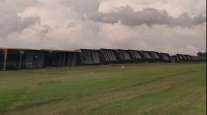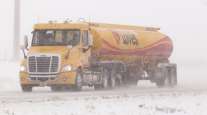Staff Reporter
Wyoming to Alert Truckers at Risk for Blow-Over Crashes

[Stay on top of transportation news: Get TTNews in your inbox.]
To help truckers avoid dangerous blow-over crashes on interstates, Wyoming transportation officials are deploying a new roadway messaging system alerting drivers about at-risk vehicle weights as wintertime’s peak accident season approaches.
Throughout the winter, the Wyoming Department of Transportation will use updated weight-based wind closure messaging for commercial vehicles and other high-profile vehicles across the state, especially in blow-over hot spots, such as parts of Interstate 80 and I-25 as well as Wyoming Highway 28.
“To provide advanced warning, we have a Commercial Vehicle Operator Portal for truck drivers to get forecasted information. We are working to enhance the system to provide specific forecasts of expected winds with potential road closures 72 hours in advance of a major event,” Vince Garcia, WYDOT intelligent transportation systems program manager, told Transport Topics.
Last year, Wyoming recorded 157 blow-over crashes, down from 178 in 2021 and 167 in 2020.
Commercial vehicles, mostly carrying general freight or traveling empty, were involved in 98% of all blow-over crashes in the state.
A trend map for the past five years indicates the worst months for blow-over crashes are December, February, January and November. A look at road conditions during these crashes shows 73% occurred on dry pavement, followed by 15% on ice/frost, 6% on snow and 5% on wet or other surfaces.
“Our roadside systems use real-time wind gusts as the basis of our weight-based wind closures. Roads are not closed, for high-profile vehicles or otherwise, until adverse conditions actually occur,” Garcia said. “However, predictive messaging on our electronic message boards, such as ‘High Wind Forecast, Expect Crosswinds 60+’ or ‘Expect Closure to Light/High Profile Vehicles,’ might be put into place a day or so in advance.”

Garcia
WYDOT’s ability to provide accurate weight restrictions during high-wind events is a result of research conducted by the University of Wyoming.
“Truckers will be warned as they enter the state and as they enter/leave a community so they can stay in a community with services if they are too light to continue through the windiest areas,” Garcia said. “As with closures due to winter conditions or crashes, traffic is stopped within locations or cities that have access to services. For example, when I-80 has a wind closure in effect, light high-profile vehicles will be stopped in Cheyenne, Laramie or Rawlins depending on where the wind impact is occurring.”
Volvo's Keith Brandis and Eric Bond take an in-depth look at how the company's SuperTruck 2 improves freight efficiency. Tune in above or by going to RoadSigns.ttnews.com.
WYDOT will monitor current and forecast wind speeds, along with road geometry, to determine how heavy a commercial vehicle or other trailer would need to be to avoid the extreme blow-over risk and update its messaging in real time.
Most truckers in blow-over crashes in Wyoming from 2018 through 2022 were driving straight ahead (84%), with only 13% negotiating a curve. Less than 1% of the commercial drivers who found themselves in blow-over accidents were engaged in slowing, passing/overtaking, changing lanes, turning or backing up.
“Unfortunately, some of the areas we see the strongest crosswinds are also highways that carry important goods and services,” Garcia said. “Our goal with this updated messaging is to facilitate as much movement as possible while keeping motorists safe.”
Want more news? Listen to today's daily briefing above or go here for more info
Truckers can register for free road and travel information tailored to their vehicles through WYDOT’s CVOP. The agency also provides comprehensive road and travel information to all drivers through the state’s 511 tools accessible at wyoroad.info or the Wyoming 511 mobile app.
“These efforts are put forth to assist commercial vehicle drivers and the general public in their pre-trip planning and to help them make informed, safe decisions as they travel throughout the state,” Garcia said. “When in doubt, wait it out.”
In the coming months, WYDOT will push these messages with blow-over at-risk weights for high-profile vehicles to all of its public information systems (the 511 telephone system, text and email alerts, and its website).





